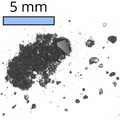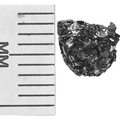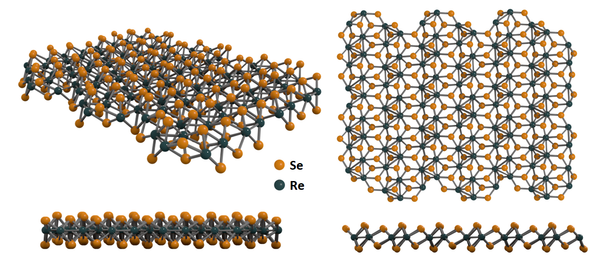Rhenium Diselenide (ReSe2) Powder and Crystal
CAS Number 12038-64-1
2D Materials, Low Dimensional Materials, Materials, Transition Metal Chalcogenides (TMCs), Transition Metal Dichalcogenides (TMDs)Low price, high purity 2D metal rhenium diselenide powder and crystals
For the development of next-generation electronics, optoelectronics, and nanotechnology
Technical Data | MSDS | Structure | Properties | Literature and Reviews | Related Products | Resources and Support
Rhenium diselenide (ReSe2), CAS number 12038-64-1, belongs to the family of layered transition metal dichalcogenide (TMDC) semiconductors with layers bound by van der Waals forces.
One of the striking physical properties of rhenium diselenide (ReSe2) is that it has a stable distorted 1T phase (1T-ReSe2) in which the underlying 1D chain arrangement of Re4 parallelograms leads to a strong in-plane anisotropy. The structural distortion causes weaker interlayer coupling, which makes its bulk material behave electronically and vibrationally like decoupled monolayers.
Due to its distorted structure (like its twin ReS2), ReSe2 has also proven to exhibit dramatic spatial-anisotropy optical response, making it possible for applications in conceptual anisotropic optoelectronic and nanomechanical devices. The triclinic symmetry of the crystal lattice caused by the Re4 “diamond-shaped” parallelograms renders it optically bi-axial, giving the rise of an inherent anisotropic in-plane polarization response. For this reason, ReSe2 and its doped hybrid materials are promising candidates for optical logic gates and optical computation.
High Purity
≥99.999% rhenium diselenide Crystal
Worldwide shipping
Quick and reliable shipping
Low Cost
Low Cost Rhenium Diselenide
Powder & Crystal
Different Forms of Rhenium Diselenide
ReSe2 devices exhibit an outstanding photoresponse to near-infrared light and field-effect transistors (FETs). Employing ReSe2 shows a p-type conduction characteristic with a current ON/OFF ratio of up to 105 and a hole-carrier mobility of 0.98 cm2V-1s-1.
We supply low price rhenium diselenide in several different forms for a range of applications.

Rhenium Diselenide Powder
Can be used for preparation of rhenium diselenide nanoplates and ultrathin films
Sold by weight
≥99.995% purity
From £220

Rhenium Diselenide Crystals by Size
Can be used to produce single or few-layer rhenium diselenide sheets via mechanical or liquid exfoliation
Small (≥10 mm2) or medium (≥25 mm2) crystals available*
≥99.999% purity
From £520
*Typical representative size, areas/dimensions may vary
Bulk single rhenium diselenide crystal is most commonly used as sources from which single or few-layer sheets can be obtained via either mechanical or liquid exfoliation.
Rhenium diselenide powder can also be used to prepare ReSe2 nanosheets and nanoparticles by liquid-exfoliation (normally assisted by sonication), especially when it is the case of foreign elements such as lithium or sodium cations being inserted between layers by the process of intercalation. Liquid exfoliation can provide mass production of such products.
Technical Data
| CAS Number | 12038-64-1 |
| Chemical Formula | ReSe2 |
| Molecular Weight | 344.13 g/mol |
| Bandgap | ~1.30 eV (direct) |
| Preparation | Synthetic - Chemical Vapor Transport (CVT) |
| Structure | Triclinic |
| Electronic Properties | 2D semiconductor |
| Melting Point | N/A |
| Color | Black |
| Synonyms | Rhenium selenide, Bis(selanylidene)rhenium |
| Classification / Family | Transition metal dichalcogenides (TMDCs), 2D semiconductor materials, Nano-electronics, Nano-photonics, Photovoltaic, Materials science |
Product Details
| Form | Purity |
|---|---|
| Powder | ≥99.995% |
| Crystal | ≥99.999% |
Pricing Table
| Product Code | Form | Size/Weight* | Price |
|---|---|---|---|
| M2140C1 | Powder | 500 mg | £220 |
| M2140C1 | Powder | 1 g | £350 |
| M2140A10 | Crystal | Small (≥10 mm2) | £520 ea. |
| M2140A25 | Crystal | Medium (≥25 mm2) | £850 ea. |
*typical representative size, areas/dimensions may vary
Shipping is free for qualifying orders.
MSDS Documents
Structure of Rhenium Diselenide
Unlike most of the TMDCs such as MoS2 and WSe2, (which crystallize in a 2H-hexagonal structure) ReSe2 shows a distorted CdCl2-type lattice structure. Each unit cell of ReSe2 contains four unit layers, which includes two categories of rhenium (Re) atoms together with four categories of selenium (Se) atoms.
The Se atoms on top and at the bottom sandwich the Re atoms in the middle to form a monolayer lattice of ReSe2. Adjacent Re atoms are bonded in a distorted zigzag four-atom parallelogram form. Calculations identified that such a distorted octahedral (1T') crystal structure with triclinic symmetry has lower energy than its hexagonal counterpart to promote stabilty.
The triclinic symmetry of the crystal lattice caused by the Re4 “diamond-shaped” parallelograms renders it optically bi-axial, giving the rise of an inherent anisotropic in-plane polarization response.

Properties of 2D Rhenium Diselenide
After exfoliation of crystals or powder, rhenium diselenide typically has the following properties:
- Trinic (1T') structure (space group: P-1)
- Strong in-plane anisotropy and in-plane polarization anisotropic response
- ReSe2 shows a p-type conduction characteristic with a current ON/OFF ratio of up to 105 and a hole-carrier mobility of 0.98 cm2V-1s-1
- Bandgap is weakly layer-dependent and decreases from 1.31 eV for thin layers to 1.29 eV in thick flakes.
Literature and Reviews
- Temperature dependence of Raman shifts in layered ReSe2 and SnSe2 semiconductor nanosheets, A. Taube, Appl. Phys. Lett. 107, 013105 (2015); doi: 10.1063/1.4926508
- Rhenium diselenide (ReSe2) infrared photodetector enhanced by (3aminopropyl)trimethoxysilane (APTMS) treatment, M. H. Alia et al., Org. Electron., 53, 14–19 (2018); doi: 10.1016/j.orgel.2017.11.006.
- Interlayer Interactions in Anisotropic Atomically-thin Rhenium Diselenide, H. Zhao et al., Nano Res., 8(11): 3651–3661 (2015); DOI: 10.1007/s12274-015-0865-0.
Related Products
We stock a wide range of 2D materials available to purchase online. Please contact us if you cannot find what you are looking for.



